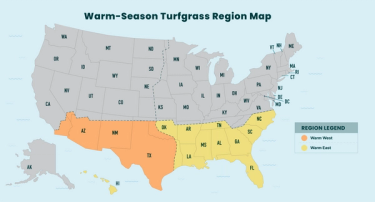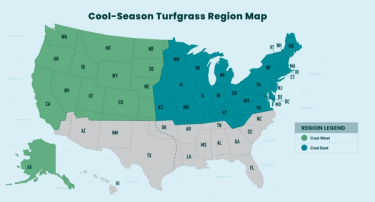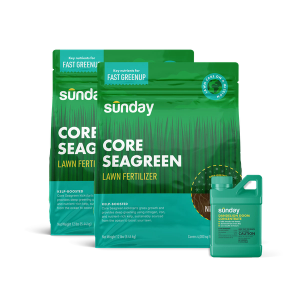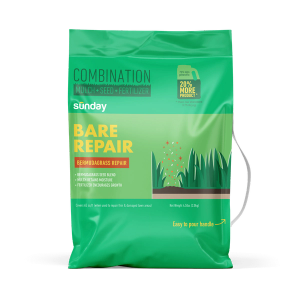We empathize with all of our customers experiencing unprecedented cold weather. While we can’t restore power or repair a broken pipe, we’re happy to share our expertise in helping your lawn recover over the next few months.
What happens to grass in extreme cold?
Warm-season grasses
Under typical weather conditions, warm-season grass is more sensitive to low light and low temperatures. Just how low? It’s all about a grass species’ ability to manage freezing water inside its tissues.
The most popular warm-season grasses—bermudagrass, zoysia, and St. Augustine—photosynthesize most efficiently in balmy summer temperatures and are likely to suffer some significant tissue damage below about 20 degrees Fahrenheit. This is what’s known as “winter kill,” and the impacts will be most significant in poorly draining soils, north-facing slopes, and areas with shade or heavy traffic. The result? The greening of your grass this spring could be delayed by several weeks.

Cool-season grasses
If you are growing cool-season grasses like Kentucky bluegrass and tall fescue in the northern or transitional zone, these grasses are cold-hardy and should not be as severely affected as warm-season grasses.
However, we recommend staying off your lawn when temperatures dip below freezing. This helps to avoid cracking or breaking of cells in grass blades and as a result, any long-term damage to your lawn.

How to recover your lawn after freezing weather
Assess the damage
When regularly scheduled temperatures return, do a quick inventory of your yard and perform a turf assay test, which will help you determine whether your grass can be saved. This can be a fun, educational activity to do as a family!
DIY Turf Assay Test
- Grab a shovel and take a small plug of grass from multiple locations around your yard. Focus on shaded, trafficked, and sloped areas, plus anywhere that saw a lot of ice or frost. Make sure you note where each sample came from!
- Bring the samples inside and treat them to tropical conditions: Lots of sun, some water, and humidity if possible. A sunny windowsill would be an ideal location!
- Wait around 2 weeks and observe. If your grass begins to regrow, then you’ll know it can be saved. If it doesn’t, reach out to our lawn advisers for personalized guidance.
Rescue remaining grass
If any of your turf samples pass the assay test, then it’s time to move on to the lawn at large. Start by heading into the yard and gently disturbing the grass surface (gently rake, then mow and collect the clippings).
If you have bermudagrass and want to spread seed, this step will help to encourage seed-to-surface contact. If you do not have bermudagrass, this step will help reduce competition and allow the stolons to grow out easier.
Sunday Tip:
What are stolons? Most warm-season grass grows from stolons—sturdy, horizontal runners that take root at various points—but store their energy in underground rhizomes.
Now, recover your lawn
Give your grass some water, then watch and wait. If you start to see some green emerging after a few weeks, congrats! Now, you have a few options.
- Feed. Anywhere you see green growth, apply fertilizer. This is also a great time to lay down some compost. It’s dark and rich and will warm up your lawn superbly as the sun shines down on it. Anywhere you don’t see green growth, see the next two options.
- Patch. If you have a cool-season lawn or a bermudagrass lawn and at least ⅔ of your grass survived, then this is a great method.
- Propagate. If you have another warm-season grass type. Chop, prop, and drop! Cut up a portion of your surviving grass and replant it in any bare spots. Apply fertilizer, then watch for regrowth!
Sunday Tip:
Not all warm-season grasses will bounce back at the same rate. While St. Augustine, bermudagrass, and centipedegrass are likely to sustain more damage, they have better recuperative abilities than slow-growing grasses like zoysia and buffalograss, which will need more time to recover.
Post-freeze lawn care tips
Watch for weeds!
Weeds are, by nature, opportunistic, and they’ll eagerly try to take over in spots where grass has been weakened. Over the next few months, keep an eye out for clover, chickweed, and other broadleaf weeds trying to make themselves at home, and spot treat with herbicides as needed.
Pre-emergents should not be applied to winter-killed areas. They can further damage your grass and delay spring greenup. If you’ve used these products in the past, now is a great time to make the switch to post-emergent spot treatment.
Be patient
Easier said than done, we know! Growing a better lawn the Sunday way means building a relationship with nature, which can sometimes be unpredictable. But like all the best relationships, what you give, you get back in spades.
Cited sources
Turfgrass Selection for Texas - Ecological Turf Tips. Texas A&M Agrilife Extension.
Winter Kill - 2010 - Part 1. University of Arkansas.



















